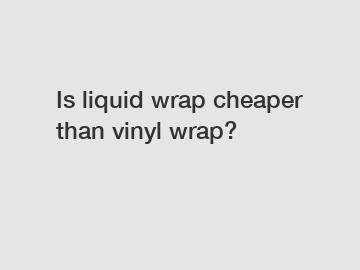Is liquid wrap cheaper than vinyl wrap?
PARMOR are exported all over the world and different industries with quality first. Our belief is to provide our customers with more and better high value-added products. Let's create a better future together.
Is liquid wrap cheaper than vinyl wrap?
When it comes to customizing the look of your vehicle, there are many options to choose from. Two popular choices are liquid wrap and vinyl wrap. Both options allow you to change the color or finish of your vehicle without committing to a permanent paint job. However, one common question that often arises is which option is cheaper – liquid wrap or vinyl wrap? In this article, we will explore the differences between the two and determine which option is more cost-effective.

Cost of materials.
One of the main factors that affect the cost of liquid wrap versus vinyl wrap is the cost of materials. Liquid wrap, also known as spray-on wrap, is a liquid substance that is sprayed onto the surface of the vehicle and dries to form a flexible protective layer. Vinyl wrap, on the other hand, is a thin, adhesive-backed material that is applied to the surface of the vehicle like a sticker.
In terms of material costs, vinyl wrap is generally cheaper than liquid wrap. Vinyl wrap comes in rolls or sheets that can be purchased in a variety of colors and finishes, ranging from matte to glossy. It is also available in different grades, with higher-quality vinyl wraps costing more. Liquid wrap, on the other hand, typically comes in cans or buckets and is sold as a liquid that needs to be sprayed onto the surface of the vehicle. Liquid wrap can be more expensive than vinyl wrap, especially when you factor in the cost of the spray gun and other equipment needed for application.
Labor costs.
Another factor to consider when comparing the cost of liquid wrap versus vinyl wrap is the labor costs involved. Both options require a certain level of skill and expertise to apply correctly, but liquid wrap can be more time-consuming and labor-intensive than vinyl wrap. Liquid wrap requires multiple coats to achieve a smooth and even finish, which can add to the overall cost of the project. Vinyl wrap, on the other hand, can be applied more quickly and easily, making it a more cost-effective option in terms of labor costs.
Durability and longevity.
When considering the cost of liquid wrap versus vinyl wrap, it is important to take into account the durability and longevity of each option. Vinyl wrap is known for its durability and can last for several years if properly maintained. However, vinyl wrap is susceptible to damage from UV rays, harsh chemicals, and abrasions. Liquid wrap, on the other hand, is more resistant to these elements and can provide a longer-lasting finish.
Conclusion.
In conclusion, while liquid wrap may have a higher upfront cost than vinyl wrap, it can offer a longer-lasting and more durable finish. If you are looking for a cost-effective option for changing the color or finish of your vehicle, vinyl wrap may be the better choice. However, if durability and longevity are important factors for you, liquid wrap may be worth the investment.
Ultimately, the decision between liquid wrap and vinyl wrap will depend on your budget, preferences, and specific needs. Whichever option you choose, make sure to work with a professional installer to ensure a high-quality finish that will last for years to come.
Contact us.
If you are considering liquid wrap or vinyl wrap for your vehicle, contact us today for more information and a quote on our services. Our team of experts can help you determine the best option for your vehicle and provide professional installation to achieve the look you desire.
For more information, please visit tanzanite blue wrap.

